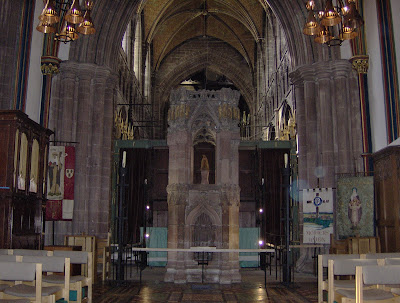This has been quite an interesting story for me – mainly because it keeps the blasted election off the news! But in truth, it’s mainly because a closure like this is almost unprecedented – even 9/11 didn’t cause this much chaos.
People keep wondering why NATS (the air traffic control people here in the UK) have taken such dramatic action. Simple. It’s for safety reasons, as aircraft cannot detect ash in the flight path. A good example is the BA flight that was caught in such an event back in 1982.
I do recall this incident, but I feel that the BBC has done a much better job of explaining what happened than I could ever do…
*********************************
When volcanic ash stopped a Jumbo at 37,000ft
 A plume of volcanic ash from Iceland has led to flights across the UK being grounded. The events around one British Airways flight in 1982 reveal the potential dangers of this sort of dust.
A plume of volcanic ash from Iceland has led to flights across the UK being grounded. The events around one British Airways flight in 1982 reveal the potential dangers of this sort of dust. When all four engines on the Boeing 747 being flown by Captain Eric Moody shut down at 37,000ft, he hadn't a clue why.
It wasn't until later, when Capt Moody, his crew and the 247 passengers on board the flight, were safely back on the ground, that he discovered the cause of the narrowly averted catastrophe - volcanic ash.
Airports are being closed across the UK after dust which spewed from a volcano in Iceland, began drifting southwards. The experience of Capt Moody, almost 30 years ago, shows the potential danger clouds of volcanic ash present to modern jet aircraft.
There had been no hint of trouble when flight BA 009 took off from Kuala Lumpur in Malaysia on the evening of 24 June, 1982.
Heading for Perth, Australia, the weather forecast for the five-hour journey was good and the crew were anticipating an uneventful flight.
The first sign of trouble came as the plane, which had hit cruising height, headed past Java over the south-eastern Indian Ocean.
Capt Moody, who had left the cockpit for a stroll, was summoned back to the flight deck. As he climbed the stairs of the Jumbo he noticed puffs of "smoke" billowing from the vents in the floor and detected an acrid smell.
When he opened the door to the cockpit he saw the windscreen ablaze with a St Elmo's fire - a discharge of static electricity.
But that alone wasn't enough to cause alarm, Capt Moody says, recalling the events when he spoke to BBC's Good Morning Scotland on Thursday.
That's not unusual in high whispy cloud. But it developed into something more than we'd ever seen before."
Looking out the side windows of the cockpit, the crew noticed the front of the engines were glowing as if lit inside.
Then Capt Moody's flight engineer detailed the impact the dust was having on the aircraft itself.
"Engine failure number four... engine failure number two," he said.
"Three's gone… They've all gone."
Within a few moments, a passenger jet powered by four Rolls Royce engines had become a glider.
Needing time to calmly consider his options, Capt Moody used autopilot to put the plane into a gentle descent, and instructed his first officer to issue a mayday call.
While the crew on the flight deck were frantically trying to figure out the cause of this freak failure, many passengers were largely unaware that anything was wrong.
But eventually, when the passenger oxygen masks dropped as the plane steepened its descent, the news had to be announced.
"Good evening ladies and gentlemen. This is your captain speaking. We have a small problem. All four engines have stopped. We are all doing our damnedest to get them going again. I trust you are not in too much distress."
Eventually, after quarter of an hour without any power, the engines were brought back to life. Ash had clogged the engines, which only restarted when enough of the molten ash solidified and broke off.
"We glided from 37,000ft to 12,000ft before we got [the engines] going again," recalls Cpt Moody.
The plane headed back to Jakarta where it landed safely, though even then one of the engines had failed again.
It was two days before investigators confirmed that volcanic ash had been responsible for the near disaster. The plane had flown into a cloud of dust spewed out by an eruption of Mount Galunggung, 110 miles south east of Jakarta.
A close examination of the plane revealed the damage a plume of these tiny particles can do to an engine - the tips of the turbine blades had been ground away. The findings were eventually incorporated into a report on the dangers of volcanic ash to aircraft.
Reflecting on the chilling events of that flight 28 years later, Capt Moody, who lives in Camberley in Surrey, shows the sort of understatement characteristic of those in his profession.
"It was, yeah, a little bit frightening."
********************
So, this is the reason why the aircraft have been prevented from flying. Yes, it’s very inconvenient, but I personally would prefer to put up with the inconvenience rather than risking having one or more engines fail whilst I am 37,000 feet thank you very much.
(You can read more about the Jakarta incident on Cpt Moody’s own website -Eric Moody - but please note that the document is in .PDF file format)
Ah well, guess I should call this quits – I'm supposed to be working, not blogging…
Back later (or when I get fed up with work again!)
Karen
Now some things you hold on to - and some you just let go
Seems like the ones that you can't have
Are the ones that you want most
































.JPG)








